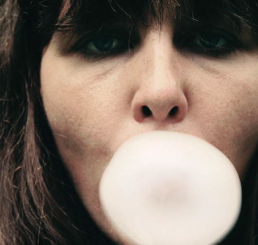Liza Ryan: Fragment catalogue essay
Catalogue Introduction for “Liza Ryan: Fragment.” 2012. Perfect bound book. Full color printing.
2013 ADDY Silver Award
In her exhibition “Fragment,” on view at the Eleanor D. Wilson Museum at Hollins University, Los Angeles-based artist Liza Ryan investigates a litany of experiences that progress gradually through her evocative and sublime imagery. Ryan’s individual works hold hefty information; as groupings, they create idiosyncratic associations that transform common moments into eerie fantasies. At the core of the exhibition, Ryan explores the notion of fragmentation, both literally and symbolically. She comments, “The fragmented, nonlinear narrative in the work mirrors our lived experiences in this sensory overloaded, information saturated, visually bombarded world.”1 Documenting the minutiae of our lives via fragments, she combines disparate elements to represent the chaos of our time.
Ryan works with photographs that she intermittently marks with ink or graphite. Her “language” includes cutting, collage, editing, appropriating, reframing and sequencing images into layered and evocative cabinets of curiosities. Her images are collected using a variety of cameras: digital, medium and large format, 35mm, toy cameras such as the Diana and Holga. She uses the medium of photography to “capture life as experienced”2 versus as a documentary tool. Usually employing natural light, the work has a real time appeal that cannot be captured by other means. In “Seer,” 2011, hands hold creamy milk over a patterned bowl. Ryan’s use of natural light suffuses the image and illuminates all. Hands, bowl and light become one. The camera acts as a divinatory mechanism, weighing light’s physicality as well as its implied metaphysical nature.
Ryan believes that we experience the world in stories. Her titles such as “Hover,” “Something tells me she didn’t look back,” “Examine My Stare,” and “This is No Place I Knew” imply action and spark an intense wordplay/image interchange.
Her images become interwoven into often-fragmented chapters. The pastiche groupings dovetail into deliberate dances that engage viewers in all directions of the composition; in many cases they push us to look at the periphery of the work, as in “I Sew Myself Together” from 2007. Comprised of twenty-one photographs arranged in a waterfall shape, the collage draws our gaze to the left and right margins of the work. Beginning with a mouth exhaling breath on the left side, our eye travels up through images of a fragmented body juxtaposed with views of nature, often referencing each other in a gesture (a torso twisted akin to a tree trunk) or a shape (the body of an eel mimicking the split in the flesh of a pomegranate). Selected images of the body are tattooed with graphite alluding to the texture of bark, further emphasizing the transformative relationship between human and nature. Our exploration ends on the right with a woman’s mouth sucking in the breath that was released by her twin on the opposite side of the composition. About her work, Ryan refers to the tension between internal and the external worlds and the terror and exhilaration involved when the two meet. 3
Deconstruction and reconstruction are among Ryan’s core proclivities. In “Exploded Moment,” 2010, she deliberately strips apart an image of a tree with amber and yellow leaves on a field of dark green loamy earth and combines
these pieces with strips of other photographs. Ryan then methodically reconstructs the image, repositioning the strips and subtlely conjoining selected sections with graphite. In the resulting collage, the residue of the gold leaves resembles an exploding constellation. Driven by Ryan’s interest in the subjectivity of time, she “explodes the moment.” Seconds are slowed down and reconfigured, allowing the viewer the opportunity to experience felt time rather than measured time.
The pinnacle work on view is Ryan’s newest cinematic creation: a site-specific wall collage titled “Rare Bloom,” 2012. Measuring sixteen feet in height by forty feet in width and undulating from the wall in projections anywhere from
five-eights of an inch to three and a quarter inches, “Rare Bloom” is comprised of one hundred and eighty images, several drawn on with white ink. Alternately depicting images of chaos and beauty, motion and stillness, tension and release, Ryan builds a pictorial flood across the museum’s environment. From blooming azaleas to forceful explosions, she offers provocative images to create experiences congruent to us all.
In Lawrence Weschler’s book, “Everything that Rises: A Book of Convergences,” he outlines our human ability to merge past events into kinships that conjoin disparate relationships in time. He observes, “I myself have increasingly found myself being visited by similarly uncanny moments of convergences, bizarre associations, eerie rhymes, whispered recollections—sometimes in the weirdest places.” 4 Narrative in nature and self referential, Ryan’s work touches non-sequentially on a timeline, creating a powerful rhythm through divergent and convergent images. Look carefully; her uncanny and deliberate selections alternately reveal and conceal the human condition.
1 Email exchange with the artist, January 2012.
2 Interview with the artist, December 2011.
3 Ibid.
4 Weschler, Lawrence. “Everything that Rises: A Book Of Convergences.” 2006. McSweeney Books: San Francisco. 1.

